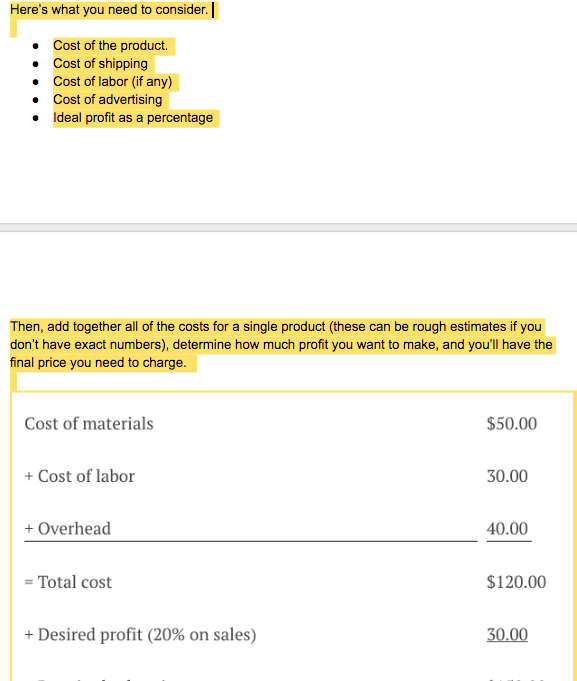Skyscraper content is ubiquitous.
Every vertical imaginable is hitting publish on a brand-spanking new, shiny 10k+ word guide.
Some marketers absolutely love the idea of publishing long-form content.
Google (sometimes) ranks these posts well (not always).
And users?
Trying to read that drivel?
And then download/opt-in/buy?
Forget it.
Most of these skyscrapers are chock-full of cringeworthy copy.
Consuming them is enough to inflict psychological and emotional harm.
Coupled with the fact that nobody actually wants to read the damn thing in the first place and you have a problem.
SEO traffic is good…
… only when it turns into buyers.
Which means somehow, some way, you need to make Skyscrapers that don’t suck so much to read.
The research and preparation behind them are amazing. The work ethic is commendable.
But visitors (read: customers) don’t care about any of that. Because they only care about themselves.
So here are seven tips to instantly improve Skyscraper readability.
1. Subheads Should Sound More like Headlines
Everyone talks about headlines.
Barely anyone focuses on subheads.
Words matter. They have a way of hinting or suggesting things to the reader.
That’s good most of the time. The right word or phrase at the right time can allow you to say more with less.
However, it can also backfire. And does, frequently, on subheads. Like this:

Side-step this issue by writing subheads like headlines.
For starters, the subhead, “Market your Products,” is too vague.
In this scenario, “market” refers to “promotion.” But technically, that’s inaccurate.
The problem is that “promotion” used to be just one subset of “marketing” back in the day. It’s only recently that we conflate “marketing” with advertising or PR.
Then, the majority of the section focuses on SEO. Technically, that’s a subset of “promotion.”
See how that’s confusing?
To make matters worse, SEO is not “active” like advertising, social media promotion, etc. So it probably isn’t the best example of “marketing promotion” (which conjures a proactive tactic).
This is a small issue.
However, this type of nuance and significance is important when you’re talking to more sophisticated audiences.
They’ll immediately sense this disconnect when reading a section.
And it immediately undercuts not only the piece’s credibility on this subject, but also the writer behind it.
In this case, if you’re sticking with an SEO-focused section of tips, switch up the subhead to be more descriptive.
It also forces you to put the emphasis right where it belongs: What someone gets out of reading this section.
Something like:
- “Optimize Your Product Pages to Get More Eyeballs”
Not perfect. A little over the top.
But a helluva lot more accurate and engaging than “market your product.”
Guaranteed readers will click on that, over “Market your Products” or 10 other similar examples, in a table of contents.
2. Explain Complex Topics Without Dumbing Them Down
Internet of Things (IoT) is a big, noteworthy trend.
If you’re a geek.
The rest of the world might need a little help understanding exactly how or where they come into contact with it in their own homes.
The trick is to explain it without dumbing it down or using 500 words to describe one topic.
A simple trick is to simply give an easily recognizable example.
No context is given below. Which would then force you to write paragraphs to explain how it relates.
![]()
Using specific examples, brand names people recognize, and a contextual link, can help you say more with less.
- “That’s the problem with Internet of Things (IoT) devices, like your Samsung smart refrigerator or Nest security camera.”
Now, (hopefully) everyone reading knows exactly what you mean.
You don’t have to say they’re “becoming popular” or include other filler because people already know they are.
3. Boring Topics Don’t Have to Be Dull
Most topics online aren’t that interesting.
The interesting ones already get video, image, or sex appeal. All others get text. And Skyscrapers.
However, just because a topic is boring doesn’t mean it has to be dull.
Exhibit A:

Boring!
Most people have personalities. They’re colorful individuals.
Yet they lock them away somewhere when it’s time to write.
Yes, hosting companies are arguably dull. Writing about parent companies behind hosting companies exponentially so.
Add a little flavor with dramatic language and unexpected descriptions:
- “This company is just the latest in a long line to be gobbled up by the massive hosting conglomerate, Endurance International Group (EIG). Or, as it’s also known, where good hosts go to die.”
OK, the tone is probably off. But you get the point.
Nobody in their right mind wants to read 10,000+ words. Especially not on their two by one-inch mobile screens.
So you gotta pull out the stops to keep them glued to their screen with vivid language that leaps off the page (err, device).
4. Take Yourself out of the Piece
Readers read for one reason: To find a solution to their problem.
Companies create Skyscrapers for one reason: To deliver a solution to their readers.
The SEO/writer in the middle should be virtually nonexistent.
But that isn’t always the case.

“What do I mean?” + “We” should be:
- “What does that mean?” + “You”
Take yourself out of the piece.
You’re writing for the reader’s point of view. Not yours.
You’re writing to get attention to a company or product. Not bring attention to yourself.
Veering off course only creates a distraction.
Stay laser-focused on what the reader is going to get out of finishing this piece.
Unless you’re a big baller, shot-caller industry “influencer,” nobody cares about you anyway.
5. Say ‘More’ with ‘Less’
Skyscrapers require high word counts.
They don’t require over articulating things that don’t need to be articulated.
Instead, like a master Zen monk or your favorite bad minimalist blogger, practice concision.

How do you count the ways this is bad? About half of it can be cut straight away:
- “Lead magnets can generate more leads for your business.”
Saying less with more means using the fewest words possible to explain something.
The beginning of that example, “One of the best ways,” is especially troublesome.
On the one hand, little phrases like this can help add a conversational tone. On the other, they’re almost always overdone.
They’re like the lazy way out. Here is a short list from just a few hours of editing:
- “One of the best ways…”
- “As you know…”
- “It’s no secret…”
- “I’ve already mentioned…”
- “In case you didn’t already know…”
- “One of the easiest ways”
- “One of the most popular and simplest resources”
- “As far as pricing goes”
You can instantly cut those out in almost half the cases and the sentence would read just fine.
If it’s “no secret,” don’t say it. If it’s “already been mentioned,” mention something else.
Deciding not to fall back on this crutch will force you to produce a much better end result.
For example, this:
![]()
Can be turned into this:
- “A logo is like a shorthand for branding.”
One succinct, eight-word sentence should be able to say more than another 27-word one.
6. Show, Don’t Tell
How, specifically, do you say more with less?
You show people.
You don’t go on and on and on and on, lecturing like (most) awful college professors.
Otherwise, it becomes a puff piece in no time. Stuffed full with more artificial fluff than an OC Housewife on Bravo.
If you tell people they should do XYZ, you should explain why and show how to do x, y, and z.
Here’s a good example that talks about profit margins:

Don’t tell the reader that profits are important. (Duh!)
Show them. Break it down like a fraction. Unpack it with specific examples.
This thin line is what separates the top 10 percent expert-sounding content from the other 90 percent bad freelance-writer content.
Here’s the latter:
- “Either way, freelancing is a great way to build lasting networking relationships and get your name out there.”
No, it’s not. It actually kinda sucks ~70 percent of the time.
Instead of filler sentences like this, dive straight into how much ghostwriters are paid, about how freelancers can make over six-figures, simple tools to make client management easier, time-management hacks the best in the business swear by, butt-saving tax tips that most freelancers get wrong, and on and on.
In other words: Show, don’t tell.
Give people a reason they should do what you’re saying. Otherwise, they won’t.
7. Sentence Length & Sequence Dictates Pacing
You must control how fast people consume information.
Here’s how not to do it:

That was supposed to be written for a beginner-ish audience. They’re not super technical.
And yet, three simple sentences are used in quick succession. Each describing a different technical component of a much larger (and more complex) system.
That’s why you lost the reader. Their eyes glazed over as a full steam of jargon ran right over them.
Yes, sentences should be short online. Yes, it helps people scan and read faster.
But there’s always an exception to the rule.
There are certain times when you want to slow things down a beat. Throw on some slow jams, light a few candles, and scatter roses when you’re building to a climax.
You’re better off making technical sentences more complex, inserting “and,” “but,” and “or.” Counterintuitively, you should also use more three and four and five sentence paragraphs in this instance.
That will give you more time to explain. And it will force the reader to slow down.
Think about your favorite song for a second. Like some eardrum-puncturing house track or “Free Bird” for you crotchety old peeps.
The tracks build slowly. They use short sequences to suck you in at the beginning. They intermix longer, slower passages to build tension in the middle. Then, they hit with staccato bursts when it’s time to blow the doors off.
Write like that.
Short, simple, succinct to speed them up.
And don’t be afraid to use complex sentence structures or multiple-sentence paragraphs to slow them down so that you have a chance convey complex information.
Conclusion
Skyscrapers require a lot of research, preparation, and production before going live.
But don’t skimp on the writing.
It is, after all, the stuff that matters.
It’s the stuff that gets indexed and ranked.
And it’s the stuff standing between you and a new customer.
More Content Marketing Resources:
- Our Skyscraper Technique Failure & the Lessons We Learned
- Write Less, Say More: Why You Need to Create Concise Content
- How to Evaluate the SEO Value of a Piece of Content
Image Credits
Featured Image: MichaelGaida /Pixabay.com
Screenshots taken by Brad Smith, January 2018.





![[SEO, PPC & Attribution] Unlocking The Power Of Offline Marketing In A Digital World](https://www.searchenginejournal.com/wp-content/uploads/2025/03/sidebar1x-534.png)